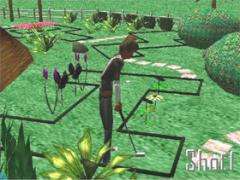Bringing Girls and Boys to Computer Science with 'Alice'

(PhysOrg.com) -- Duke University computer scientist Susan Rodger is hoping ice skaters, cute animals and fearsome dragons will bring new talent to her field.
With support from the National Science Foundation, she and collaborators nationwide are using the power of storytelling to draw younger students into programming. An animation program called "Alice," invented by the late Randy Pausch of Carnegie Mellon University, allows student programmers of all ages to create their own worlds without realizing they're actually writing code.
Rodger recalled the rush of introducing fourth-to-sixth graders to Alice during an annual event that brings elementary school girls to the Duke campus to meet with female professors.
"They learned Alice for half an hour, and then they got to create a world with it," Rodger said. "'Oh, wow, look!' they told each other. 'Come here. Show me. Look at this!' They were creating little stories with Alice, and in the process they were programming. They didn't know they were doing programming, but they were."
At Alice summer camps for middle-schoolers at Duke, "students were very engaged with Alice and were always asking for more time to work on their own worlds," Rodger reported at the March 2009 Technical Symposium on Computer Science Education in Chattanooga, Tenn. "After five or six hours of Alice each day, we still had difficulty getting them to stop, turn off their Alice worlds and logoff at the end of the day."
Interestingly, those camps were "50 percent male and 50 percent female," she said.
Attracting females is key to the future of computer science, Rodger says. In 2008, only 11.8 percent of U.S. bachelor's degrees in computer science went to women, according to the Computing Research Association. And Duke's showing is hardly better, said Rodger, who is trying to turn that around by making programming fun to learn.
"In my most recent upper-level undergraduate course I had one female out of 15 students, and that's pretty typical," Rodger said. "It's a nationwide problem that there aren't many women in computer science in general. For example, we only have three women faculty in our department, out of 24 positions. And it's been the same for the 15 years I've been here."
Rodger, a professor of the practice at Duke, thinks Alice breaks stereotypes about what computer science is as students solve problems by inventing scenarios within virtual worlds. Those worlds are created by the students themselves, and populated with the objects, animals and people they introduce by drag-and-drop.
"It's a very easy way to learn programming if you've never done it before," she said. "It's hard to make mistakes. What you learn in the process are computer science concepts."
Student projects in Rodger's computer science course for non-majors recently included an animated nine-hole miniature golf course, complete with smoking volcano. Another placed Sarah Palin in a "seaplane adventure" in which Alaska's governor has to save her husband after his snowmobile breaks down. A third was an elaborate board game called "Roll."
Simpler projects, replete with mooing cows, hopping kangaroos, fire breathing dragons and bumper cars, would resonate with younger students, she said.
Studies show Alice's story-telling quality especially appeals to young women and minority students, Rodger said. And Alice's interactive computer games especially appeal to young men.
Rodger thinks early computer gaming draw a number of students to computer science, but those tend to be males. "There are a lot of shoot-'em-up games in particular that kids are playing," she said. "That turns off a lot of girls, who in general like to help people and tend to be more social."
Alice can handle both tastes. "Girls want to use animals and characters to tell a story," she said. "Boys want to use sci-fi objects, vehicles and lots of fire."
Rodger realizes that incorporating Alice in her computer science course for non-majors will not in itself convince many more young women or men to enter her field if they're already juniors or seniors.
So she's focusing on the next generation, now learning Alice in the middle schools of Durham. The National Science Foundation incentive has also created programs based in San Jose, Calif; Denver, Charleston, S.C. and Oxford, Miss.
The next Alice events at Duke, all for teachers, will include a June 17 symposium and a series of workshops that month and in early July.
"It's going to take four or five years to see if all those efforts are helping," she said.
Provided by Duke University (news : web)

















